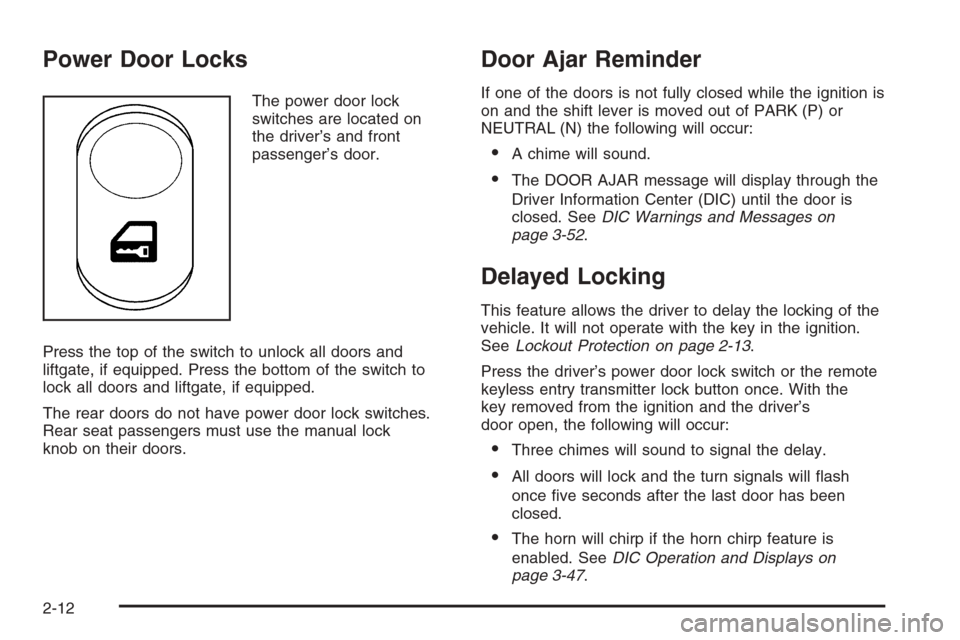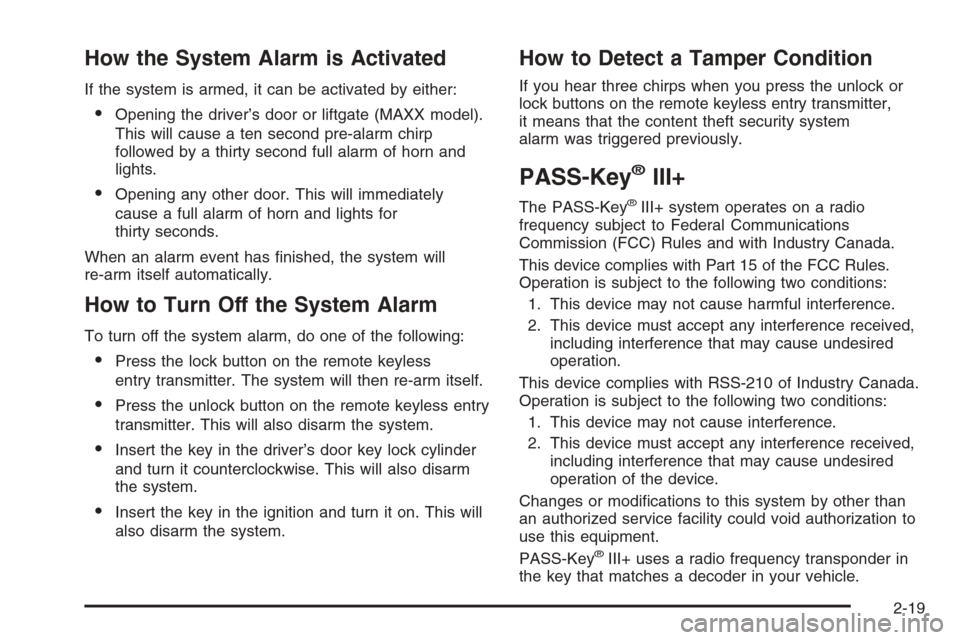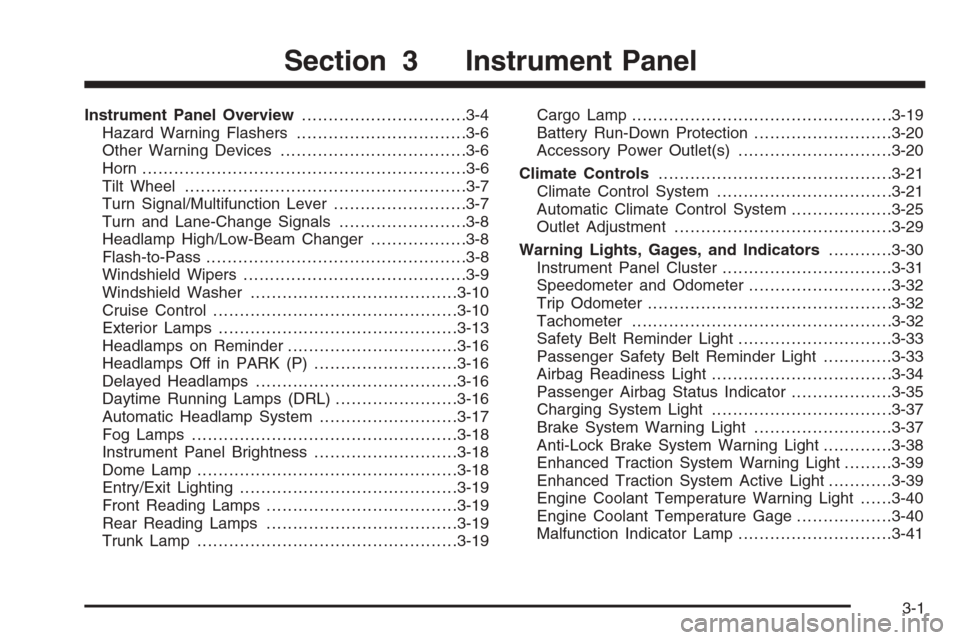2005 CHEVROLET MALIBU horn
[x] Cancel search: hornPage 88 of 434

The following functions may be available if your vehicle
has the remote keyless entry system:
/(Remote Vehicle Start):If your vehicle has this
feature, the engine may be started from outside
the vehicle using the remote keyless entry transmitter.
See “Remote Vehicle Start” at the end of this section for
more detailed information.
Q(Lock):Press the lock button to lock all the doors.
The interior lamps will turn off after all of the doors
are closed. If enabled through the Driver Information
Center (DIC), the remote lock feedback can be
programmed to have the horn chirp and/or the parking
lamps �ash when the remote keyless entry transmitter
is used to lock the vehicle’s doors. See “LOCK HORN”
and “LIGHT FLASH” underDIC Operation and
Displays on page 3-47for more information.
Pressing the lock button may arm the content
theft-deterrent system. SeeContent Theft-Deterrent on
page 2-18.
K(Unlock):Press the unlock button to unlock the
driver’s door. If the button is pressed again within
�ve seconds, all remaining doors, and the liftgate will
unlock. The interior lamps will turn on and stay on
for 20 seconds or until the ignition is turned on.
If enabled through the DIC, the remote unlock feedback
can be programmed to have the horn chirp and/or
the parking lamps �ash when the remote keyless entry
transmitter is used to unlock the vehicle’s doors.
See “UNLOCK HORN” and “LIGHT FLASH” underDIC
Operation and Displays on page 3-47for more
information.
If enabled through the DIC, and it is dark enough
outside, the vehicle’s high-beam headlamps, parking
lamps, and back-up lamps will turn on each time
the unlock button on the transmitter is pressed. These
exterior lamps will stay on for 20 seconds, or until a door
is opened. See “EXT (Exterior) LIGHTS” underDIC
Operation and Displays on page 3-47.
Pressing the unlock button will disarm the content
theft-deterrent system, if equipped. SeeContent
Theft-Deterrent on page 2-18.
2-6
Page 89 of 434

V(Remote Trunk/Liftgate Release):The trunk or
liftgate will open when this button on the transmitter
is pressed and held for approximately one second. You
can open the sedan trunk with the transmitter when
the vehicle is stationary. You can open the liftgate on the
MAXX only when the vehicle is in PARK (P).
L(Vehicle Locator/Panic Alarm):This button may
be used to locate your vehicle. Press and release
this button to initiate vehicle locate. The horn will sound
three times and the headlamps and parking lamps
will �ash three times. Press and hold the button
for approximately three seconds to initiate the panic
alarm. The horn will sound and the headlamps
and parking lamps will �ash for 30 seconds. Press the
button again to cancel the panic alarm.
Matching Transmitter(s) to Your
Vehicle
Each remote keyless entry transmitter is coded to
prevent another transmitter from unlocking your vehicle.
If a transmitter is lost or stolen, a replacement can
be purchased through your GM dealer. Remember to
bring any remaining transmitters with you when you go
to your dealer. Each vehicle can have a maximum of
four transmitters matched to it.
Battery Replacement
Under normal use, the battery in your remote keyless
entry transmitter should last about four years.
You can tell the battery is weak if the transmitter will not
work at the normal range in any location. If you have
to get close to your vehicle before the transmitter works,
it is probably time to change the battery.
The KEY FOB BATT LOW message in the vehicle’s
DIC will display if the remote keyless entry transmitter
battery is low.
2-7
Page 94 of 434

Power Door Locks
The power door lock
switches are located on
the driver’s and front
passenger’s door.
Press the top of the switch to unlock all doors and
liftgate, if equipped. Press the bottom of the switch to
lock all doors and liftgate, if equipped.
The rear doors do not have power door lock switches.
Rear seat passengers must use the manual lock
knob on their doors.
Door Ajar Reminder
If one of the doors is not fully closed while the ignition is
on and the shift lever is moved out of PARK (P) or
NEUTRAL (N) the following will occur:
A chime will sound.
The DOOR AJAR message will display through the
Driver Information Center (DIC) until the door is
closed. SeeDIC Warnings and Messages on
page 3-52.
Delayed Locking
This feature allows the driver to delay the locking of the
vehicle. It will not operate with the key in the ignition.
SeeLockout Protection on page 2-13.
Press the driver’s power door lock switch or the remote
keyless entry transmitter lock button once. With the
key removed from the ignition and the driver’s
door open, the following will occur:
Three chimes will sound to signal the delay.
All doors will lock and the turn signals will �ash
once �ve seconds after the last door has been
closed.
The horn will chirp if the horn chirp feature is
enabled. SeeDIC Operation and Displays on
page 3-47.
2-12
Page 101 of 434

How the System Alarm is Activated
If the system is armed, it can be activated by either:
Opening the driver’s door or liftgate (MAXX model).
This will cause a ten second pre-alarm chirp
followed by a thirty second full alarm of horn and
lights.
Opening any other door. This will immediately
cause a full alarm of horn and lights for
thirty seconds.
When an alarm event has �nished, the system will
re-arm itself automatically.
How to Turn Off the System Alarm
To turn off the system alarm, do one of the following:
Press the lock button on the remote keyless
entry transmitter. The system will then re-arm itself.
Press the unlock button on the remote keyless entry
transmitter. This will also disarm the system.
Insert the key in the driver’s door key lock cylinder
and turn it counterclockwise. This will also disarm
the system.
Insert the key in the ignition and turn it on. This will
also disarm the system.
How to Detect a Tamper Condition
If you hear three chirps when you press the unlock or
lock buttons on the remote keyless entry transmitter,
it means that the content theft security system
alarm was triggered previously.
PASS-Key®III+
The PASS-Key®III+ system operates on a radio
frequency subject to Federal Communications
Commission (FCC) Rules and with Industry Canada.
This device complies with Part 15 of the FCC Rules.
Operation is subject to the following two conditions:
1. This device may not cause harmful interference.
2. This device must accept any interference received,
including interference that may cause undesired
operation.
This device complies with RSS-210 of Industry Canada.
Operation is subject to the following two conditions:
1. This device may not cause interference.
2. This device must accept any interference received,
including interference that may cause undesired
operation of the device.
Changes or modi�cations to this system by other than
an authorized service facility could void authorization to
use this equipment.
PASS-Key
®III+ uses a radio frequency transponder in
the key that matches a decoder in your vehicle.
2-19
Page 131 of 434

Instrument Panel Overview...............................3-4
Hazard Warning Flashers................................3-6
Other Warning Devices...................................3-6
Horn .............................................................3-6
Tilt Wheel.....................................................3-7
Turn Signal/Multifunction Lever.........................3-7
Turn and Lane-Change Signals........................3-8
Headlamp High/Low-Beam Changer..................3-8
Flash-to-Pass.................................................3-8
Windshield Wipers..........................................3-9
Windshield Washer.......................................3-10
Cruise Control..............................................3-10
Exterior Lamps.............................................3-13
Headlamps on Reminder................................3-16
Headlamps Off in PARK (P)...........................3-16
Delayed Headlamps......................................3-16
Daytime Running Lamps (DRL).......................3-16
Automatic Headlamp System..........................3-17
Fog Lamps ..................................................3-18
Instrument Panel Brightness...........................3-18
Dome Lamp .................................................3-18
Entry/Exit Lighting.........................................3-19
Front Reading Lamps....................................3-19
Rear Reading Lamps....................................3-19
Trunk Lamp.................................................3-19Cargo Lamp.................................................3-19
Battery Run-Down Protection..........................3-20
Accessory Power Outlet(s).............................3-20
Climate Controls............................................3-21
Climate Control System.................................3-21
Automatic Climate Control System...................3-25
Outlet Adjustment.........................................3-29
Warning Lights, Gages, and Indicators............3-30
Instrument Panel Cluster................................3-31
Speedometer and Odometer...........................3-32
Trip Odometer..............................................3-32
Tachometer.................................................3-32
Safety Belt Reminder Light.............................3-33
Passenger Safety Belt Reminder Light.............3-33
Airbag Readiness Light..................................3-34
Passenger Airbag Status Indicator...................3-35
Charging System Light..................................3-37
Brake System Warning Light..........................3-37
Anti-Lock Brake System Warning Light.............3-38
Enhanced Traction System Warning Light.........3-39
Enhanced Traction System Active Light............3-39
Engine Coolant Temperature Warning Light......3-40
Engine Coolant Temperature Gage..................3-40
Malfunction Indicator Lamp.............................3-41
Section 3 Instrument Panel
3-1
Page 135 of 434

The main components of your instrument panel are the following:
A. Side Window Outlets. SeeClimate Control System
on page 3-21.
B. Turn Signal/Multifunction Lever. SeeTurn
Signal/Multifunction Lever on page 3-7.
C. Steering Wheel Controls and Cruise Controls
(If Equipped). SeeAudio Steering Wheel Controls
on page 3-119andCruise Control on page 3-10.
D. Instrument Panel Cluster. SeeInstrument Panel
Cluster on page 3-31.
E. Windshield Wiper/Washer Lever. SeeWindshield
Wipers on page 3-9.
F. Ignition Switch. SeeIgnition Positions on page 2-22.
G. Hazard Warning Flasher. SeeHazard Warning
Flashers on page 3-6.
H. Center Air Outlets. SeeClimate Control System on
page 3-21.
I. Audio System. SeeAudio System(s) on page 3-54.
J. Climate Control System. SeeClimate Control
System on page 3-21.
K. Glove Box. SeeGlove Box on page 2-44.L. Side Air Outlets. SeeClimate Control System
on page 3-21.
M. Adjustable Pedal Buttons (If Equipped). See
Adjustable Throttle and Brake Pedal on page 2-24.
N. Instrument Panel Brightness Control. SeeInstrument
Panel Brightness on page 3-18.
O. Fog Lamps (If Equipped). SeeFog Lamps on
page 3-18.
P. Hood Release. SeeHood Release on page 5-11.
Q. Parking Brake. SeeParking Brake on page 2-29.
R. Horn. SeeHorn on page 3-6.
S. Accessory Power Outlet. SeeAccessory Power
Outlet(s) on page 3-20.
T. Shift Lever. SeeShifting Into Park (P) on page 2-29.
U. Center Console Storage Compartment. See
Center Console Storage Area on page 2-44.
V. Traction Control Button (If Equipped). SeeEnhanced
Traction System (ETS) on page 4-8.
W. Rear Wiper/Washer Controls (If Equipped).
SeeWindshield Washer on page 3-10.
3-5
Page 136 of 434

Hazard Warning Flashers
Your hazard warning �ashers let you warn others. They
also let police know you have a problem. Your front
and rear turn signal lamps will �ash on and off.
The hazard warning
�asher button is located
in the center of the
instrument panel.
Your hazard warning �ashers work no matter what
position your key is in, and even if the key is not in.
Press the button to make the front and rear turn
signal lamps �ash on and off. Press the button again
to turn the �ashers off.
When the hazard warning �ashers are on, your turn
signals will not work.
Other Warning Devices
If you carry re�ective triangles, you can set them up
at the side of the road about 300 feet (100 m) behind
your vehicle.
Horn
Press near or on the horn symbols on your steering
wheel pad to sound the horn.
Tilt Wheel
A tilt and telescope wheel allows you to adjust the
steering wheel before you drive. You can raise
the steering wheel to the highest level to give your
legs more room when you enter and exit the vehicle.
3-6
Page 183 of 434

In addition to the engine oil life system monitoring the
oil life, additional maintenance is recommended in the
Maintenance Schedule in this manual. SeeEngine Oil
on page 5-15andScheduled Maintenance on page 6-4.
Always reset the engine oil life system after an oil
change. See “How to Reset the Engine Oil Life System”
underEngine Oil Life System on page 5-18.
Personalization
The following options can be accessed in order by
pressing the MENU button anytime while the vehicle
is in on. Press this button to scroll through each option.
All of the personalization options may not be available
on your vehicle. Only the options available will be
displayed on your DIC.
Oil Life Reset
Units Selection (English/Metric)
Remote Start Capability
Horn Chirp During Remote Keyless Entry Locking
Horn Chirp During Remote Keyless Entry Unlocking
Exterior Light Flash During Remote Keyless
Entry Locking or Unlocking
Delayed Locking
Automatic Vehicle Unlocking: Speci�c Doors
Automatic Vehicle Unlocking: When Key is Off or
When Shift To Park
Exterior Perimeter Lighting During Remote Keyless
Entry Unlock
Security System Passive or Remote Keyless Entry
Arming
Select Language: (English, French, Spanish or
German)
When the desired option is reached, use the ENTER
button to toggle between the modes of that option.
To make a selection, press the MENU button again.
If no selection is made within ten seconds, the display
will revert back to the previous information displayed.
The MENU mode is exited when the INFO button is
pressed, a ten second time period has elapsed, the
ignition is turned to off or the end of the MENU list is
reached.
The following display messages may appear on your
vehicle’s audio display by pressing the MENU button:
OIL LIFE RESET:When this option is displayed, you
can reset the engine oil life system. To reset the system
to 100%, press and hold the ENTER button for at least
one second. An ACKNOWLEDGED display message
will appear for three seconds or until the next button is
pressed. This will tell you the system has been reset.
SeeEngine Oil Life System on page 5-18for more
information.
3-53